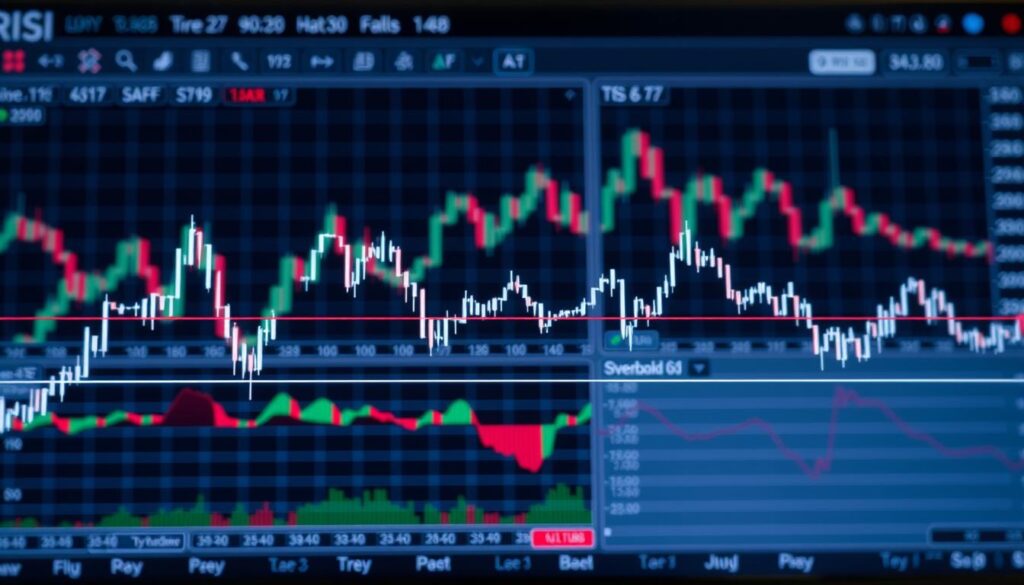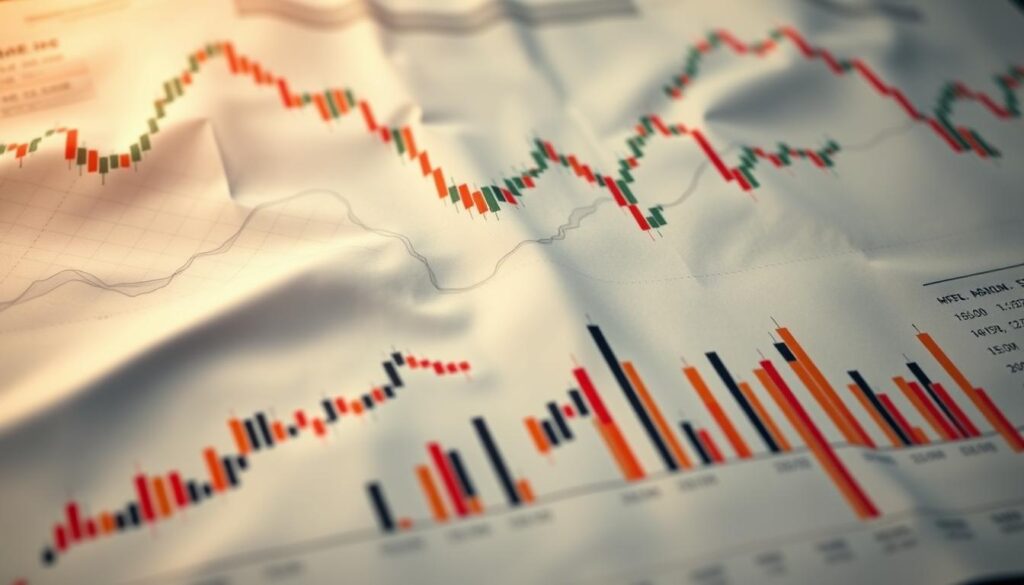Now Reading: Best Crypto Technical Indicators for Day Trading: Top Picks
- 01
Best Crypto Technical Indicators for Day Trading: Top Picks
Best Crypto Technical Indicators for Day Trading: Top Picks

Navigating cryptocurrency markets requires specialized tools and strategies. The fast-paced nature of digital asset trading demands quick analysis and precise decision-making. Day traders need reliable methods to identify opportunities in this 24/7 environment.
Successful market participants rely on analytical tools to interpret price movements. These tools help filter out noise and focus on meaningful patterns. Understanding market behavior becomes clearer with the right analytical approach.
This guide explores the most effective analytical methods for short-term digital asset strategies. We’ll examine tools that combine momentum tracking, trend analysis, and volatility measurement. Each approach offers unique insights into market conditions and potential opportunities.
Key Takeaways
- Cryptocurrency markets operate 24/7 with high volatility
- Effective analytical tools help identify trends and momentum
- Different indicators serve various purposes in market analysis
- Combining multiple approaches provides comprehensive market insight
- Proper tool selection can improve trading decision accuracy
- Understanding indicator strengths and limitations is crucial
- Systematic analysis reduces emotional decision-making
Understanding Cryptocurrency Technical Analysis
Market participants use historical data to identify recurring patterns in asset price movements. This approach forms the foundation of modern market examination techniques.
Defining Technical Analysis in Crypto
Technical analysis involves studying past price action and trading volume to forecast future direction. Practitioners believe all available information reflects in current market prices.
This method focuses exclusively on price data rather than fundamental factors. The approach assumes human psychology creates predictable patterns across different market conditions.
Historical Context and Dow Theory
Charles Dow established the framework for technical analysis in the late 1800s. His observations of stock price movements created enduring principles for market examination.
Dow Theory identifies three distinct trend types that apply to modern digital assets. Primary trends represent major bull or bear markets lasting months or years. Secondary trends show temporary corrections against the primary direction.
The theory emphasizes that trends continue until clear reversal signals appear. Volume confirmation strengthens trend validity across different market indices.
| Dow Theory Principle | Core Concept | Modern Application |
|---|---|---|
| Price Incorporates All Information | Market prices reflect all known data instantly | Focus on price action over external news |
| Three Trend Types | Primary, secondary, and minor trends coexist | Identify different time frame opportunities |
| Volume Confirmation | Trends require volume support for validity | Use volume indicators to confirm movements |
| Trend Persistence | Trends continue until definitive reversal | Ride established trends rather than predict turns |
Key Trading Tools for Crypto Day Trading
Visual representations of market activity form the foundation of effective trading decisions. Different chart formats display price information in unique ways, each serving specific analytical purposes.
Basic Chart Types and Their Uses
Line charts offer the simplest view by connecting closing prices across time periods. This format helps identify overall trend direction without intraday noise.
Bar charts provide more detailed information through OHLC data. Each bar shows opening, high, low, and closing values for the selected interval.
Candlestick charts present the same OHLC data with enhanced visual clarity. The colored body immediately indicates whether the closing price was higher or lower than the opening price.
Each candlestick reveals market sentiment through its body and wicks. The body represents the opening-to-closing range, while wicks show the highest and lowest prices reached.
Traders can analyze these charts across multiple time frames. Short-term participants often use one-minute to hourly intervals for precise entry points.
Understanding chart reading forms the essential first step toward applying analytical tools effectively. These visual representations translate raw market data into actionable insights.
Best Crypto Technical Indicators for Day Trading
Effective market analysis tools transform chaotic price movements into structured decision-making frameworks. These quantitative measurements help participants navigate volatile conditions with greater confidence.
Why These Indicators Matter
Analytical tools serve distinct purposes in market examination. Some overlay directly on price charts, while others appear in separate panels below or above.
Volume-based measurements provide additional confirmation for price movements. All these tools derive their data from either price action or trading volume.
Successful strategies always use these tools alongside actual price confirmation. This approach prevents false signals and improves decision accuracy.
Different tools work better for specific time frames and risk profiles. Short-term approaches require different settings than longer-term examinations.
Combining complementary tools creates stronger signals through confluence. Multiple confirming measurements increase the probability of successful outcomes.
Understanding each tool’s purpose helps avoid common interpretation errors. Proper application requires knowing what market conditions each tool identifies best.
Mastering Moving Averages for Trend Analysis
Calculating average values over specific periods transforms volatile charts into readable patterns. These tools help market participants identify underlying trend directions by smoothing out short-term fluctuations.

Moving averages create dynamic lines that follow price action while filtering market noise. This approach provides clearer signals about market momentum and potential direction changes.
Simple vs. Exponential Moving Averages
The two primary types serve different analytical purposes. Simple moving averages give equal weight to all data points in the calculation period.
Exponential moving averages prioritize recent price action for quicker response times. This makes them more sensitive to current market conditions.
| Feature | Simple Moving Average | Exponential Moving Average |
|---|---|---|
| Calculation Method | Equal weight to all periods | Greater weight to recent data |
| Responsiveness | Slower to price changes | Faster reaction to new information |
| Best Use Case | Longer-term trend confirmation | Short-term momentum shifts |
| Signal Lag | More lag in signals | Less lag, earlier signals |
Using Crossovers for Signal Generation
Moving average crossovers create clear entry and exit signals. When a shorter-period average crosses above a longer one, it suggests bullish momentum.
The opposite crossover indicates potential downward movement. These signals help traders time their positions effectively.
Multiple averages can confirm trend strength through their spacing and slope. Widely separated lines indicate strong trending conditions.
Harnessing the Power of MACD
Gerald Appel’s 1970s creation revolutionized momentum tracking for market participants. This versatile tool combines trend-following and momentum characteristics in one indicator.
Understanding MACD and Its Components
The Moving Average Convergence Divergence uses two exponential moving averages to generate signals. The MACD line represents the difference between 12-period and 26-period averages.
A second line called the signal line acts as a trigger for trading decisions. This 9-period average of the MACD line creates the crossover signals traders watch closely.
These two lines fluctuate around a zero centerline with no upper or lower limits. The histogram visually displays the distance between the MACD line and signal line.
Signal Line Crossovers and Divergences
When the MACD line crosses above the signal line, it suggests strengthening upward momentum. The opposite crossover indicates potential downward movement.
Divergence occurs when price action and the MACD move in opposite directions. Bullish divergence happens when price makes lower lows while MACD forms higher lows.
Centerline crossovers provide additional confirmation of trend changes. The MACD crossing above zero confirms bullish momentum has taken control.
Decoding the Relative Strength Index (RSI)
J. Welles Wilder’s 1978 innovation brought mathematical precision to momentum measurement in volatile markets. The relative strength index calculates recent gains against losses over a standard 14-period timeframe. This creates a bounded oscillator that moves between 0 and 100.

This momentum indicator helps market participants gauge whether buying or selling pressure dominates current conditions. Readings above 70 traditionally suggest overbought territory where assets may be due for pullbacks. Values below 30 indicate oversold conditions where bounce potential increases.
Identifying Overbought and Oversold Conditions
The relative strength index excels at spotting momentum exhaustion before it appears in price action. Day traders often adjust threshold levels based on market character. Strong trending conditions might use 80/20 levels instead of standard 70/30 boundaries.
Divergence trading represents another powerful application of this strength index. Bullish divergence occurs when price makes new lows while the indicator forms higher lows. This signals weakening downward momentum despite falling prices.
Failure swings provide high-probability reversal signals focusing exclusively on RSI behavior. A bullish failure swing happens when the indicator bounces from oversold territory and breaks its previous high. This occurs without returning to oversold levels.
| RSI Strategy | Signal Mechanism | Market Condition |
|---|---|---|
| Overbought/Oversold | Crossing 70/30 thresholds | Ranging markets |
| Divergence Trading | Price/indicator disagreement | Trend exhaustion |
| Failure Swings | Pure indicator behavior | Reversal confirmation |
Combining RSI signals with price structure analysis significantly improves decision reliability. Waiting for divergence to coincide with tests of key chart patterns creates stronger confirmation. This approach helps traders navigate volatile conditions with greater confidence.
The indicator’s effectiveness comes from quantifying momentum shifts that may not be immediately visible. Alert participants can use these signals for advance warning of potential reversals. Proper interpretation requires understanding both the strength index calculations and market context.
Exploring Support and Resistance Levels
Supply and demand imbalances create natural stopping points in asset valuation movements. These critical zones represent where buying and selling pressure reach equilibrium. Understanding these levels helps market participants anticipate potential price reactions.
Support forms when downward movement halts as buyers absorb available supply. This creates a floor where demand increases sufficiently to stop declines. Resistance appears during upward moves when sellers match buying pressure.
Chart Patterns: Dynamic Support and Resistance
Chart formations create moving barriers that adjust with price action. Triangles, channels, and other patterns establish boundaries where valuation may reverse. These dynamic levels provide continuously adjusting reference points.
Each test of these zones increases their psychological significance. Traders observe repeated bounces and gain confidence in the levels’ importance. This creates self-fulfilling behavior that reinforces the barriers.
Volume analysis provides crucial confirmation at these critical junctures. High volume during tests indicates strong participant interest. Low volume suggests vulnerability to level breakdown.
Professional participants mark multiple support and resistance levels across timeframes. This creates a roadmap of potential reaction zones. The approach helps anticipate where price may pause or reverse during sessions.
The Visual Edge: Using Candlestick and Bar Charts
Visual charting methods transform raw market data into actionable trading insights through intuitive design. These graphical representations help participants quickly assess market conditions and identify potential opportunities.

Each candlestick displays four critical price points in a single visual element. The body shows the range between opening and closing price, while wicks reveal the session’s high and low points.
Color coding provides immediate sentiment feedback. Green candles indicate buyers controlled the session with higher closing price than opening. Red candles show sellers dominated with lower closing values.
Time interval selection significantly impacts the information revealed. Short-term traders use one-minute to hourly charts for precise entries. Longer-term participants rely on daily and weekly intervals for broader trends.
Bar charts offer identical data through different visual structure. The left tick marks opening price, right tick shows closing price, and vertical line displays the range.
Comparing consecutive closing prices helps identify momentum direction. Series of higher closes signal building uptrends, while lower closes indicate downward pressure.
These visual tools accelerate pattern recognition across different time frames. Experienced traders quickly scan formations that historically precede significant movements.
Bollinger Bands: Assessing Market Volatility
John Bollinger’s volatility bands offer a dynamic approach to market analysis through statistical measurement. This tool creates an envelope around price action that automatically adjusts to current conditions.
The bands consist of three components: a middle simple moving average with upper and lower boundaries set by standard deviation. These boundaries expand during active periods and contract during calm markets.
Trading the Squeeze and Breakouts
The “squeeze” occurs when bands narrow significantly, indicating compressed volatility. This consolidation often precedes substantial price movements in either direction.
Breakouts from squeezed bands provide high-probability trading opportunities. When price pushes through the upper band with volume confirmation, it suggests strong upward momentum.
Market participants watch for consistent band touches to confirm trend strength. In uptrends, price frequently tests the upper boundary without immediately reversing.
| Market Condition | Band Behavior | Trading Approach |
|---|---|---|
| High Volatility | Bands expand widely | Trend-following strategies |
| Low Volatility | Bands contract tightly | Breakout preparation |
| Ranging Markets | Price bounces between bands | Mean reversion trading |
The middle band serves as crucial support or resistance during trends. Price maintaining position above this line indicates bullish market structure.
Combining this indicator with momentum tools creates powerful confirmation signals. This approach helps filter false breakouts and improves decision accuracy.
Incorporating Fibonacci Retracements and Trend Lines
Fibonacci retracements offer a mathematical approach to identifying potential reversal zones in volatile markets. These tools use ratios derived from the Fibonacci sequence to mark critical price levels where assets often find support or resistance. The most watched ratios include 38.2%, 50%, and the important 61.8% golden ratio.
Market participants apply these tools by measuring significant price swings. They draw retracement levels from swing low to high in uptrends, or high to low in downtrends. These horizontal points indicate where pullbacks might reverse.
Setting Key Price Targets
Trend lines complement Fibonacci analysis by connecting swing points diagonally. When a Fibonacci level aligns with a trend line, it creates a high-probability zone. Traders watch these confluence areas for potential entries.
Fibonacci extensions help set profit targets beyond the initial swing. Common extension levels include 127.2% and 161.8%. These projections indicate where a trend might exhaust.
| Fibonacci Level | Primary Function | Trader Psychology |
|---|---|---|
| 38.2% | Shallow pullback support | Early trend continuation |
| 50% | Moderate retracement zone | Balance between buyers/sellers |
| 61.8% | Deep retracement level | Critical decision point |
Successful traders often combine these tools with other methods. For detailed Fibonacci retracement strategies, many resources exist. The approach works because many participants watch the same price levels.
Dynamic trend lines adjust as new points develop. This flexibility helps maintain accurate support and resistance lines. The combination provides a clear framework for navigating market trends.
Combining Multiple Indicators for Confluence
Successful traders often layer different analytical tools to confirm market signals. This approach creates confluence when multiple methods point toward the same opportunity.
Confluence significantly increases signal reliability compared to single-indicator analysis. It filters out noise and false alerts that can mislead participants.
Strategies to Avoid Conflicting Signals
Choose complementary tools that measure different market aspects. Pair trend-following indicators with momentum oscillators and volume measurements.
Avoid using multiple tools that provide similar information. This redundancy creates confusion rather than clarity. Conflicting signals often indicate uncertain market conditions where caution is advised.
Limit your chart to three to five well-chosen indicators. Too many tools can lead to analysis paralysis and missed opportunities.
Optimizing Entry and Exit Points
Wait for alignment between your chosen indicators and price action. Look for support tests with oversold readings and bullish crossovers simultaneously.
Exit strategies should monitor when original entry conditions change. Overbought levels, target hits, or divergence signals suggest taking profits.
This layered approach helps identify potential turning points with greater confidence. It transforms random price movements into structured trading decisions.
Essential Considerations for Crypto Day Trading
Professional market participants understand that analytical tools alone cannot guarantee success. The foundation of profitable short-term strategies lies in disciplined execution and capital preservation.

Effective approaches combine technical signals with robust money management principles. This balance separates consistent performers from those who experience volatile results.
Risk Management and Market Timing
Capital protection remains the highest priority for active participants. Experts recommend risking only 1-2% of total funds on any single position.
Position sizing calculations must account for the distance to protective stops. This ensures losses remain controlled if the market moves against the entry.
The 24/7 nature of digital asset markets requires adapted timing strategies. Increased activity often occurs during major financial market overlaps.
Volume analysis provides crucial confirmation for entry decisions. High participation levels suggest genuine interest behind price movements.
Psychological discipline often proves more valuable than analytical skill. Maintaining emotional control prevents revenge trades and overtrading.
Successful participants maintain detailed journals to identify performance patterns. This helps refine strategies and avoid repeating mistakes.
Realistic expectations about win rates and profit targets support long-term sustainability. Favorable risk-reward ratios often matter more than frequency of wins.
Integrating Technical Analysis with Trading Platforms
Today’s analytical software provides seamless integration between market examination tools and order placement systems. Modern interfaces combine charting capabilities with execution functionality in unified environments.
These platforms eliminate the need for switching between multiple applications. Traders can analyze price action and execute orders from a single workspace.
Platform Comparison for Active Participants
TradingView has become the industry standard for chart analysis. It offers extensive libraries of tools and real-time data across hundreds of exchanges.
The platform’s social features enable knowledge sharing among traders. Participants can follow experienced analysts and learn from community insights.
Kraken Pro provides professional-grade charting specifically for digital asset trading. It combines advanced analysis capabilities with direct order execution.
Coinigy aggregates data from multiple exchanges into a unified interface. This allows consistent analysis across different market venues.
| Platform Feature | TradingView | Kraken Pro | Coinigy |
|---|---|---|---|
| Chart Customization | Extensive options | Professional tools | Multi-exchange view |
| Data Sources | Hundreds of exchanges | Kraken exchange | Multiple exchanges |
| Execution Integration | Broker connections | Direct trading | Unified trading |
| Social Features | Community sharing | Limited | Basic |
Platform selection should consider available tools and execution speed. Quality data feeds are crucial for accurate volume analysis.
Most platforms offer customizable workspaces for efficient workflows. These environments support rapid decision-making in fast-moving conditions.
Educational resources help traders improve their skills continuously. Many platforms provide tutorials on technical analysis methods and strategy development.
Conclusion
Building sustainable trading results requires integrating technical signals with psychological discipline. The most successful market participants develop systematic approaches that combine complementary tools while maintaining strict risk management protocols.
No single indicator provides perfect signals across all conditions. Professional traders emphasize confirmation from multiple sources before committing capital. This layered approach filters noise and improves decision accuracy.
Continuous learning remains essential in evolving digital asset markets. The comprehensive toolkit covered—from moving averages to Fibonacci levels—addresses trend identification, momentum measurement, and precise timing.
Focus on mastering a core set of methods that complement your style. Deep expertise with a few tools typically outperforms superficial knowledge of many. Ultimately, disciplined execution matters more than finding “secret” indicators.
FAQ
What is the main purpose of using technical analysis in cryptocurrency markets?
The primary goal is to evaluate investments and identify trading opportunities by analyzing statistical trends gathered from trading activity, such as price movement and volume. It helps traders forecast potential future price direction based on historical market data.
How does the Moving Average Convergence Divergence (MACD) indicator generate signals?
The MACD generates signals through the interaction of its two lines: the MACD line and the signal line. A bullish signal occurs when the MACD line crosses above the signal line, suggesting upward momentum. A bearish signal happens when it crosses below, indicating potential downward pressure.
What do overbought and oversold levels on the Relative Strength Index (RSI) mean?
An RSI reading above 70 typically suggests an asset is overbought and may be due for a price correction or pullback. A reading below 30 indicates an oversold condition, which might signal a potential buying opportunity as selling pressure could be exhausted.
Why are support and resistance levels considered fundamental concepts?
These levels are crucial because they represent price points on a chart where the forces of supply and demand meet. Support is a price level where buying interest is strong enough to halt a decline, while resistance is where selling pressure stops an advance. They help traders identify potential entry and exit points.
Can I rely on a single indicator for my trading decisions?
Relying on just one tool is generally not advised. Using a combination of indicators, like moving averages for trend direction and RSI for momentum, provides confluence. This multi-faceted approach helps filter out false signals and offers a more robust view of the market’s condition.
How important is trading volume when using these analytical tools?
Volume is a critical confirming factor. High volume during a price breakout from a resistance level or a moving average crossover adds credibility to the signal. It indicates stronger market participation and conviction behind the price move, making the signal more reliable.













